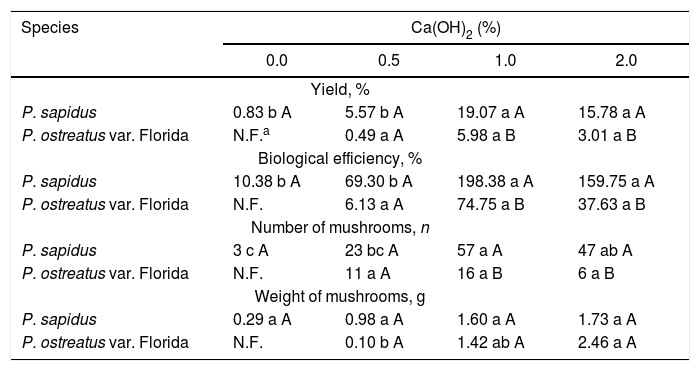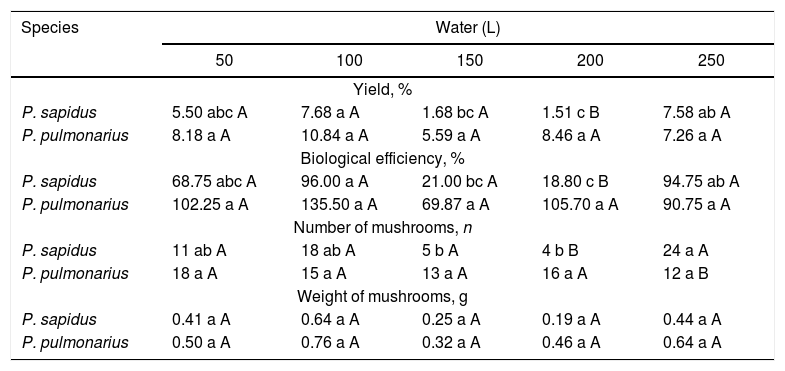The aim of this research was to evaluate the efficiency of aqueous alkali-treated Brachiaria straw for the cultivation of appropriate species of oyster mushroom. The substrate used in the cultivation of various Pleurotus spp. was soaked for 20min by using two different procedures: (i) 0.5–2.0% Ca(OH)2 in 100L water, and (ii) 50–250L water. As a result, 1% Ca(OH)2 dissolved in 100L water and 3.5kg of Brachiaria straw presented the best production. The most suitable species for the application of the present method were P. pulmonarius and P. sapidus. The success of this technique is directly related to the concentration of Ca(OH)2 and water, the species, and the origin and quality of raw material used as the substrate in the production of oyster mushroom.
Worldwide, diverse treatments have been used to prepare substrates for mushroom cultivation, with the objective to eliminate fungal contamination and microorganisms.1–3 The principal methods are composting and steam pasteurization, but these treatments require a high energy outlay.4,5 The alkaline method is a simple procedure that is mainly used in rural communities, where small-scale production will suffice. Compared to other strategies, this method presents many advantages, such as low-cost, the highest biological efficiency, no fungal contamination, a shorter colonization time,6,7 and energy absence.
The principal substrates studied in the cultivation of mushroom using the alkaline method include banana leaves, “palmareca” leaves, corn cob, and corn straw.7,8 Conversely, the food industry is always producing high quantities of agricultural wastes, like Brachiaria straw.9 Growers of mushroom are continually searching for various substrates to improve the production with low cost.10 The ability of Pleurotus genera to grow on a variety of organic materials is a valuable differential to increase the world production and consumption of this mushroom, represented by various species, such as P. ostreatus var. Florida, P. sapidus, P. pulmonarius, P. djamor, and P. cornucopiae var. citrinopileatus.
Hence, this research aimed to evaluate the efficiency of aqueous alkali-treated Brachiaria straw for the cultivation of appropriate species of culinary-medicinal oyster mushroom. Particular focus was given to the Ca(OH)2 and water contents, to determine the optimal formulation to achieve the highest yield parameters.
The following three fungi strains were used: P. sapidus, P. ostreatus var. Florida, and P. pulmonarius. Stocks of all strains are deposited at the fungal collection of the São Paulo State University, Câmpus de Dracena (São Paulo, Brazil) and accessible to other researchers who are interested in continuing the present research.
The grain spawn was produced using sorghum seeds, as outlined in the method presented by Zied et al.11 Briefly, the seeds were boiled at 100°C for 30h and then placed (0.5kg wet weight) in polyethylene bags and mixed with CaSO4 (1%) and limestone (0.5%). Afterward, the bags were inoculated with the Pleurotus species and incubated in a dark room at 25°C for 15 days.
Edible fungi were produced on Brachiaria straw, broken into 4–8cm pieces using a hammer mill. The chemical composition of the straw was 6.6% protein, 29.5% fiber, 57.4% carbon, 0.3% phosphorus, 1.06% nitrogen, and a C/N ratio of 54/1. Two experimentation conditions of substrate preparation were performed. In both experiments, water and Ca(OH)2 were mixed for 2min to ensure a perfect homogenization before soaking of the Brachiaria straw. In the first, the substrate was soaked (3.5kg wet weight) in a plastic container with 100L water and 0.0 (control), 0.5, 1.0, and 2.0% Ca(OH)2, respectively, for 20min (Supporting File). In the second, the Brachiaria straw was soaked (3.5kg wet weight) in a plastic container containing 1.0% Ca(OH)2 (best level reported in first procedure) and 50, 100, 150, 200, and 250L water, respectively, for 20min. In both experiment after soaking the Brachiaria straw was drained in plastic box for 60min (Supporting File). Afterward, in plastic bags the substrate (2.5kg wet weight) were inoculated with 2% (w/w) spawn (sorghum seeds), and incubated in a dark room at 25°C and 70% relative humidity.
The yield parameters of the fruit bodies were evaluated based on the yield (Y), biological efficiency (BE), number of mushrooms (NM), and weight of mushrooms (AFB).12–15 For Y, the basidiocarp fresh weight was divided by the compost fresh weight, multiplied by 100, and expressed as a percentage. BE was calculated as the basidiocarp fresh weight divided by the compost dry weight, multiplied by 100, and expressed as a percentage. The count of the harvested basidiocarps represented the NM. For calculation of the AFB, the basidiocarp fresh weight was divided by the number of basidiocarps and expressed in grams.
Both experimental procedures adopted a double factorial design. In the first, eight treatments (two species×four Ca(OH)2 contents) were considered, with seven replicates, resulting in a degree of residual freedom with a value of 18. The second consisted of ten treatments (two species×five water contents), with seven replicates, resulting in a degree of residual freedom with a value of 24. ANOVA was used to analyze the data, and Tukey's test was employed to establish significant differences between means (p≤0.05). All calculations were performed using the SAS JMP software.
According to the results in Table 1, compared to cultivation of P. sapidus in the presence of Ca(OH)2, the treatment control showed the lowest yield parameters for this species while P. ostreatus var. Florida was not produced under this condition (no Ca(OH)2). Otherwise, 1% Ca(OH)2 presented the highest yield for both strains, with P. sapidus recording the highest values of Y (19.07%), BE (198.38%), NM (57), and AFB (1.60g). In comparison, values of Y (5.98%), BE (74.75%), NM (16), and AFB (1.42g) were recorded for P. ostreatus var. Florida. Significantly superior, P. sapidus species can be cultivated in small and low technological mushroom growers using 1–2% Ca(OH)2.
Yield parameters of Pleurotus spp. using different amounts of Ca(OH)2.
| Species | Ca(OH)2 (%) | |||
|---|---|---|---|---|
| 0.0 | 0.5 | 1.0 | 2.0 | |
| Yield, % | ||||
| P. sapidus | 0.83 b A | 5.57 b A | 19.07 a A | 15.78 a A |
| P. ostreatus var. Florida | N.F.a | 0.49 a A | 5.98 a B | 3.01 a B |
| Biological efficiency, % | ||||
| P. sapidus | 10.38 b A | 69.30 b A | 198.38 a A | 159.75 a A |
| P. ostreatus var. Florida | N.F. | 6.13 a A | 74.75 a B | 37.63 a B |
| Number of mushrooms, n | ||||
| P. sapidus | 3 c A | 23 bc A | 57 a A | 47 ab A |
| P. ostreatus var. Florida | N.F. | 11 a A | 16 a B | 6 a B |
| Weight of mushrooms, g | ||||
| P. sapidus | 0.29 a A | 0.98 a A | 1.60 a A | 1.73 a A |
| P. ostreatus var. Florida | N.F. | 0.10 b A | 1.42 ab A | 2.46 a A |
Depending on the concentrations and alkaline chemical, literature results vary among the studies. Villa-Cruz et al.16 obtained a BE of P. ostreatus between 70.6% and 72.0% when a mixture of corn-cobs and coffee pulp was soaked in a solution of water with lime (2%). Bernabé-González et al.17 cultivated P. pulmonarius on dry banana leaves using two treatments. In the first treatment, the substrate was immersed in a solution of water with lime (2%) for 24h, reaching a BE of 120.1%. By contrast, a lower BE (41.4–81.2%) was obtained when the substrate was immersed in hot water at 80°C for 1h. In the present study, the best results of BE with the species P. ostreatus was 74.75% and P. pulmonarius was 135.50%.
According to the positive results obtained by P. sapidus species for the 1% Ca(OH)2 diluted in 100L water, a second procedure was done, to verify the viability of the production of the P. pulmonarius species. In this trial, we also established if the volume of 3.5kg Brachiaria would be influenced by the amount of water used to soak the straw.
Again, the 1% Ca(OH)2 in 100L water showed the highest yield for both species. In this instance, P. pulmonarius exhibited the highest values of Y (10.84%), BE (135.50%), NM (15), and AFB (0.76g). Conversely, P. sapidus displayed values of Y (7.68%), BE (96%), NM (18), and AFB (0.64g). The water content for soaking of the Brachiaria does not influence the average weight of the mushrooms. The treatments that obtained a superior Y and BE provided a high NM harvested (Table 2).
Production of Pleurotus spp. using 1% Ca(OH)2 and different water contents.
| Species | Water (L) | ||||
|---|---|---|---|---|---|
| 50 | 100 | 150 | 200 | 250 | |
| Yield, % | |||||
| P. sapidus | 5.50 abc A | 7.68 a A | 1.68 bc A | 1.51 c B | 7.58 ab A |
| P. pulmonarius | 8.18 a A | 10.84 a A | 5.59 a A | 8.46 a A | 7.26 a A |
| Biological efficiency, % | |||||
| P. sapidus | 68.75 abc A | 96.00 a A | 21.00 bc A | 18.80 c B | 94.75 ab A |
| P. pulmonarius | 102.25 a A | 135.50 a A | 69.87 a A | 105.70 a A | 90.75 a A |
| Number of mushrooms, n | |||||
| P. sapidus | 11 ab A | 18 ab A | 5 b A | 4 b B | 24 a A |
| P. pulmonarius | 18 a A | 15 a A | 13 a A | 16 a A | 12 a B |
| Weight of mushrooms, g | |||||
| P. sapidus | 0.41 a A | 0.64 a A | 0.25 a A | 0.19 a A | 0.44 a A |
| P. pulmonarius | 0.50 a A | 0.76 a A | 0.32 a A | 0.46 a A | 0.64 a A |
Values followed by different lowercase letters within a line and uppercase letters within a column are significantly different among the yield parameters at p<0.05, according to Tukey's test, n=7.
The differences in the Y and BE of P. sapidus between the first and second procedures was due to the quality of the Brachiaria straw used. In the first study, the presence of pests did not occur, whereas, in the second study, the presence of larvae and adult sciarid flies was verified (Supporting File). Thus, the presented method does not have efficient insect control unlike that over contaminating fungi. Stölzer and Grabbe18 reported that the alkaline method is favored owing to its ability to reduce the microorganisms and also for its low cost and efficiency.
Therefore, batches of old straw and those stored under poor conditions should be avoided when applying this approach. Another alternative would be the use of a biological or chemical treatment together with the soaking of the straw. Rodriguez Estrada and Pecchia5 reported that sciarids are the main fly that affects Pleurotus crops in North America. These pests heavily impact the crop if they enter the cultivation rooms during the incubation stage when the substrate temperature is around 24°C.
Thus, the success of this technique is directly related to the concentration of Ca(OH)2 and water, the species, and the origin and quality of raw material used as the substrate in the production of oyster mushroom.
Financial support was received through FAPESP Project: 2015/15306-3, IPN-SIP Project: 20170419, and CONACYT Project: CB-2016-611914.





